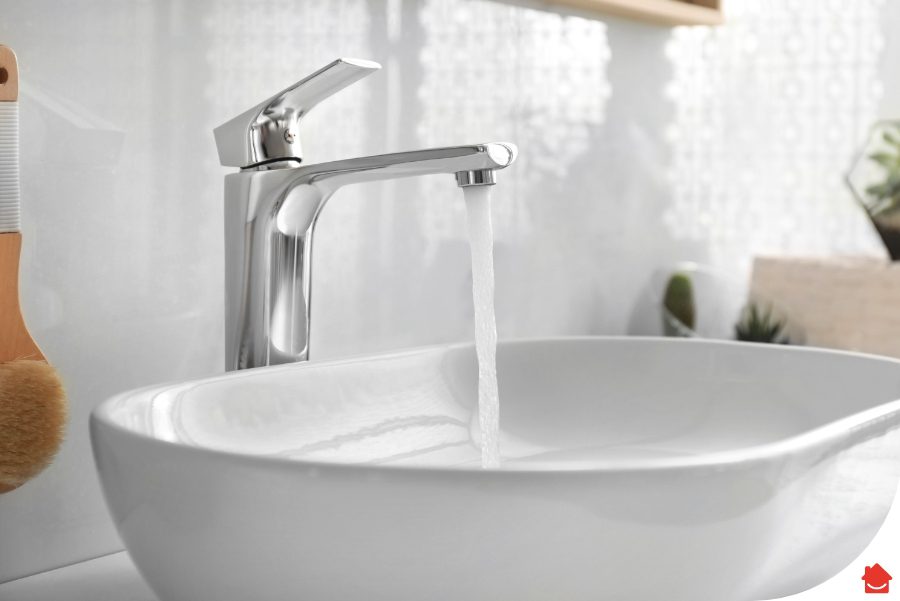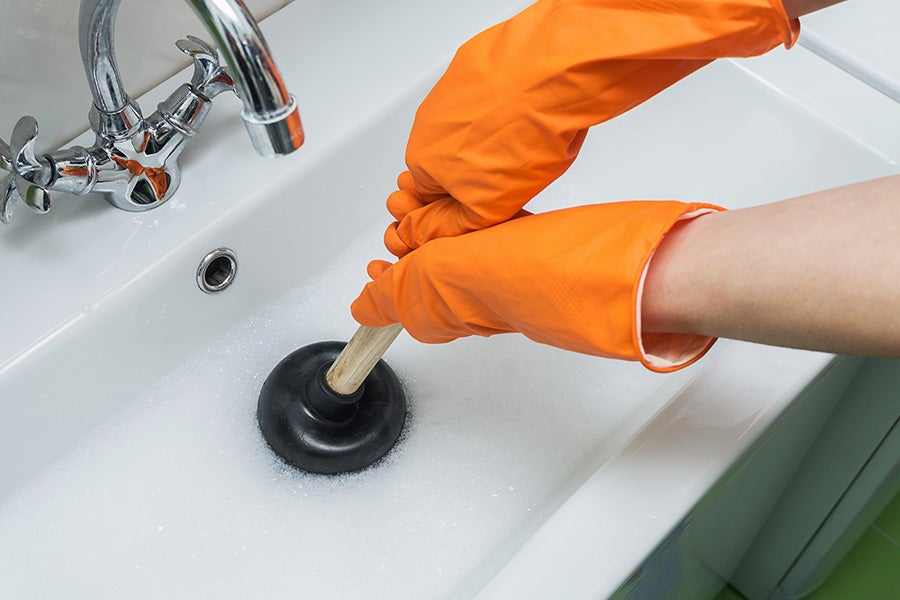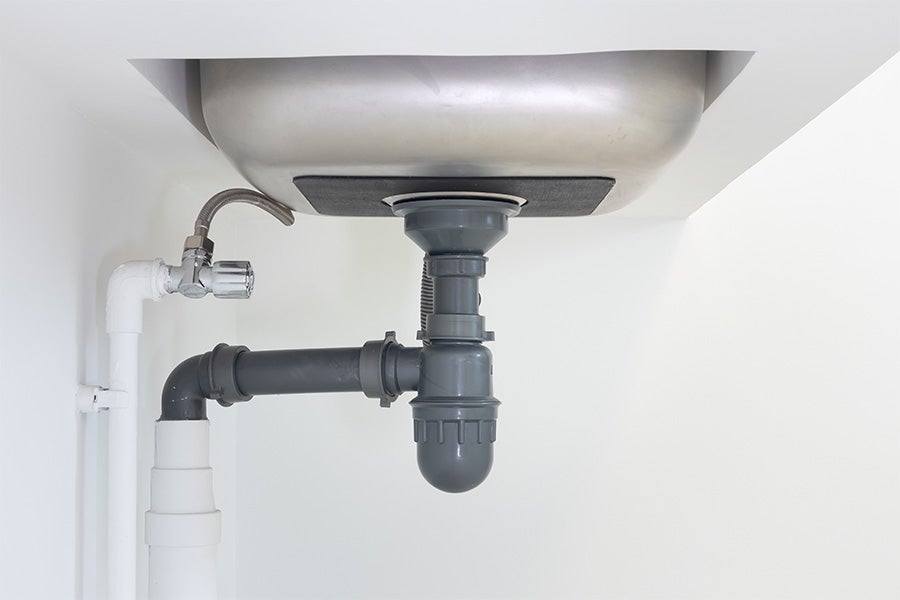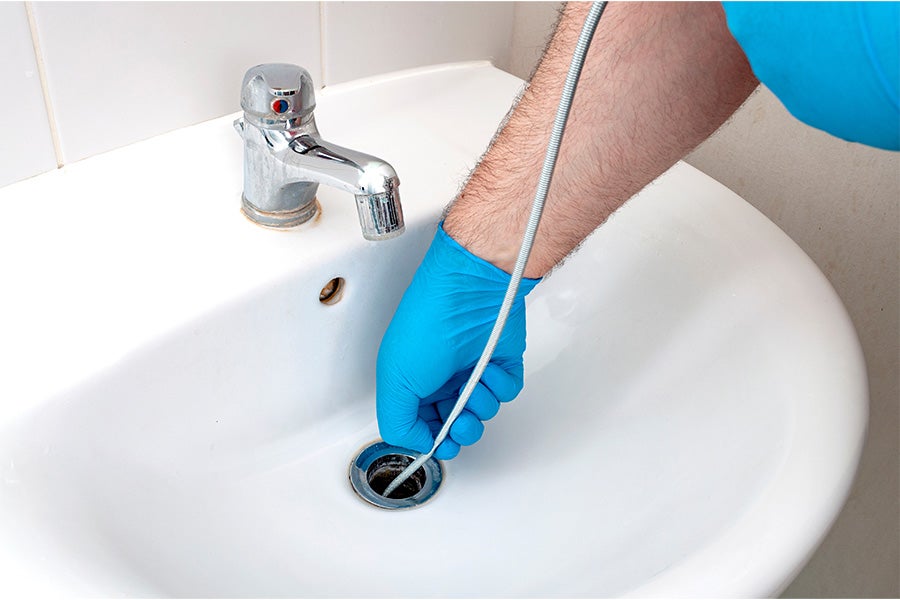Plumbing advice
Why is my bathroom sink not draining?
26 May 2025 • 9 minutes

Plumbing advice
26 May 2025 • 9 minutes
Service Excellence Coach

Blocked bathroom sinks are more common than you might think. In fact, 5.3% of all plumbing and drainage claims at HomeServe in 2024 were for blocked sinks, showers, or baths.
The good news? Once you know what’s causing it, it’s easier to fix and even easier to prevent. Some common culprits include:
There are several quick and easy methods you can try yourself using everyday items from around the house. Here are five effective ways to get things flowing again:

Sometimes, using a plunger is the way to go when clearing a pipe blockage in your sink. Make sure you use a flat-bottomed plunger so you can get a really good seal on your plughole.
Using boiling water is one of the simplest ways to clear minor blockages caused by soap scum, toothpaste, or grease buildup. Here's how to do it:
Tip: This method works best for slow drains, not complete blockages. It’s especially effective when combined with baking soda and vinegar beforehand (check out the next method for how to do this).
Cleaning your drains with baking soda and vinegar can help to get rid of product buildup and also keep them smelling fresh. You can do this on its own or after removing hair and soap scum:

The sink’s P-trap is the curved bit of the drainpipe underneath your sink (sometimes called the U-bend). It’s a common spot for gunk to build up, slowing or blocking drainage. Here’s how to check and clear it:
If the blockage is still there, it might be something more stubborn. In that case, try our drain snake method below to tackle it head-on.

For horribly stubborn blockages, it’s sometimes necessary to bust out a drain snake (also known as a drain auger). This thin, flexible tool reaches deep into the pipes to dislodge tough blockages. Don’t have one? A straightened wire coat hanger with a small hooked end can do the job just fine.
We always recommend using natural solutions like baking soda and vinegar to clean your drains over commercial drain cleaners.
Harsh chemical cleaners can be corrosive to older pipes, which can damage your plumbing over time. They’re also harmful to the environment, with residues that can affect wildlife and water quality. Plus, their fumes can linger and potentially irritate your skin or eyes during everyday use.
Natural alternatives are safer, gentler, and just as effective for regular drain maintenance.
Standing water in a bathroom sink is due to a full or partial clog. The best way to combat standing water in a bathroom sink is to remove the clog, either by applying a soda and vinegar solution as we explained above. Alternatively, you can remove the plug and manually extract the hair build-up and scum. Sometimes, a combination of the two methods works best.
One of the easiest ways to prevent bathroom sink blockages is by being mindful of what goes down the drain.
By knowing where these items belong, you’ll reduce the risk of clogs and help to keep your plumbing in good shape.
Keep your drains fresh and free-flowing with a few simple habits: run hot water after each use, use a drain cover to catch debris and empty it daily, pour any leftover boiled water down the bathroom sink to help kill bacteria, and drop in some baking soda once a week (especially useful before going away).
If you’ve tried all the methods above and your sink still isn’t draining, it might be time to call a plumber. Signs you need professional help include:
And if you’re not comfortable taking apart pipes yourself, it’s always best to leave it to the experts to avoid further damage.
We get it. Your home is important to you, and when something goes wrong with your plumbing or drains, you want peace of mind. That’s why we offer Plumbing and Drainage cover, helping to protect you in the event of unexpected plumbing problems.
With expert help just a call away, you can relax knowing that we’ve got it covered.
Liam has been working for HomeServe for over 18 years, starting as a water supply engineer then obtaining the required qualifications and venturing into Plumbing and Drainage, expanding his knowledge of the sector.
There are not many places left in England where Liam has not completed a job for HomeServe. He’s worked on water from 4” pipes to 15 mm pipes. One of his biggest jobs to date was installing the water supply pipe to one of the training pools for the Olympics in London 2012. Liam is now one of our Service Excellence Coaches, who help support our engineers in the field.
Why HomeServe?Liam has been with HomeServe for so long because of the commitment they have on being the best, striving to give the customers the best journey. Many businesses do not care about their staff, this is not the case at HomeServe who put it at the heart of what they do.
18 years working in Water Supply, Plumbing and Drainage.
Liam has been working for HomeServe for over 18 years, starting as a water supply engineer then obtaining the required qualifications and venturing into Plumbing and Drainage, expanding his knowledge of the sector.
There are not many places left in England where Liam has not completed a job for HomeServe. He’s worked on water from 4” pipes to 15 mm pipes. One of his biggest jobs to date was installing the water supply pipe to one of the training pools for the Olympics in London 2012. Liam is now one of our Service Excellence Coaches, who help support our engineers in the field.
Why HomeServe?Liam has been with HomeServe for so long because of the commitment they have on being the best, striving to give the customers the best journey. Many businesses do not care about their staff, this is not the case at HomeServe who put it at the heart of what they do.
18 years working in Water Supply, Plumbing and Drainage.
Our help & advice articles cover Plumbing, Home heating, Electrical, Energy-saving and Home maintenance.